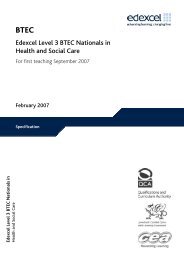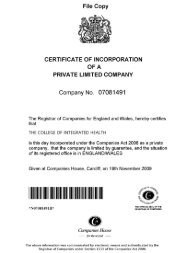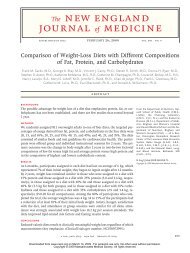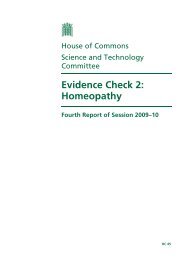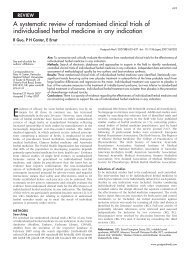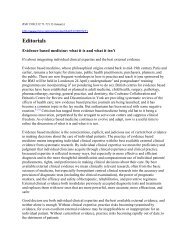German Acupuncture Trials (GERAC) for Chronic Low Back Pain
German Acupuncture Trials (GERAC) for Chronic Low Back Pain
German Acupuncture Trials (GERAC) for Chronic Low Back Pain
You also want an ePaper? Increase the reach of your titles
YUMPU automatically turns print PDFs into web optimized ePapers that Google loves.
The strengths of our study include an active multimodal<br />
conventional therapy control group, high-power, regular<br />
monitoring, assessment of blinding maintenance, structured<br />
telephone interviews, a clinically relevant primary<br />
outcome, and a low dropout rate. Potential limitations of<br />
the study were restricting acupuncture to needling only,<br />
restricting the number of sessions to 10 to 15, and inability<br />
to blind acupuncturists to the <strong>for</strong>m of acupuncture. However,<br />
we believe that nonblinding of acupuncturists did not<br />
lead to major bias because patient blinding to type of acupuncture<br />
was maintained even <strong>for</strong> 6 months.<br />
<strong>Acupuncture</strong> constitutes a strong therapy alternative<br />
to multimodal conventional therapy. <strong>Acupuncture</strong> gives<br />
physicians a promising and effective treatment option <strong>for</strong><br />
chronic low back pain, with few adverse effects or contraindications.<br />
The improvements in all primary and<br />
secondary outcome measures were significant and lasted<br />
long after completion of treatment. Because they directly<br />
compared acupuncture and conventional therapy,<br />
the <strong>GERAC</strong> trials were the decisive trials on which the<br />
<strong>German</strong> Federal Joint Committee of Physicians and Health<br />
Insurance Plans, a body similar to the National Institute<br />
<strong>for</strong> Health and Clinical Excellence in the United Kingdom<br />
or the National Institutes of Health in the United<br />
States, based its decision to make acupuncture <strong>for</strong> chronic<br />
low back pain an insured benefit, <strong>for</strong> the first time putting<br />
acupuncture on an equal footing with conventional<br />
therapy.<br />
Accepted <strong>for</strong> Publication: May 20, 2007.<br />
Correspondence: Heinz G. Endres, MD, Department of<br />
Medical In<strong>for</strong>matics, Statistics and Epidemiology, Ruhr-<br />
Universität Bochum, Universitaetsstrasse 150, D-44801<br />
Bochum, <strong>German</strong>y (heinz.endres@ruhr-uni-bochum<br />
.de).<br />
Author Contributions: Dr Müller and Ms Schade-Brittinger<br />
had full access to all of the data in the study and take responsibility<br />
<strong>for</strong> the integrity of the data and the accuracy of the<br />
dataanalysis.Studyconceptanddesign:Haake,Müller,Schade-<br />
Brittinger, Basler, Schäfer, Maier, Endres, Trampisch, and<br />
Molsberger. Acquisition of data: Schade-Brittinger and Maier.Analysisandinterpretationofdata:Haake,Müller,Schade-<br />
Brittinger,Endres,andMolsberger.Draftingofthemanuscript:<br />
Haake,Müller,Schade-Brittinger,Basler,Schäfer,Maier,Endres,Trampisch,andMolsberger.Criticalrevisionofthemanuscript<strong>for</strong>importantintellectualcontent:Haake,Müller,Schade-<br />
Brittinger, Basler, Schäfer, Maier, Endres, and Molsberger.<br />
Statisticalanalysis:Müller,Schäfer,andTrampisch.Obtained<br />
funding: Schäfer. Administrative, technical, and material support:Schade-Brittinger,Basler,Maier,andMolsberger.Study<br />
supervision: Molsberger.<br />
Financial Disclosure: None reported.<br />
Funding/Support: This study was supported by the following<br />
<strong>German</strong> public health insurance companies: AllgemeineOrtskrankenkasse,Betriebskrankenkasse,Innungskrankenkasse,<br />
Bundesknappschaft, Bundesverband der Landwirtschaftlichen<br />
Krankenkassen, and Seekasse.<br />
Role of the Sponsors: The funders had no role in the design<br />
and conduct of the study; data collection, management,<br />
analysis, and interpretation of the data; or preparation,<br />
review, or approval of the manuscript.<br />
Additional Contributions: We thank the patients and colleagues<br />
in the participating centers involved in this project<br />
and the members of the independent data and safety monitoring<br />
committee <strong>for</strong> their recommendations. The staff<br />
of Winicker Norimed (Nuremberg) and the Coordination<br />
Centers <strong>for</strong> Clinical <strong>Trials</strong> of the Universities of<br />
Düsseldorf, Heidelberg, Mainz, and Marburg contributed<br />
to monitoring and study management (http://www<br />
.kks-netzwerk.de).<br />
REFERENCES<br />
1. Andersson GB. Epidemiological features of chronic low-back pain. Lancet. 1999;<br />
354(9178):581-585.<br />
2. Pai S, Sundaram LJ. <strong>Low</strong> back pain: an economic assessment in the United States.<br />
Orthop Clin North Am. 2004;35(1):1-5.<br />
3. Deyo RA, Weinstein JN. <strong>Low</strong> back pain. N Engl J Med. 2001;344(5):363-370.<br />
4. Carragee EJ. Clinical practice: persistent low back pain. N Engl J Med. 2005;352<br />
(18):1891-1898.<br />
5. Furlan AD, van Tulder MW, Cherkin DC, et al. <strong>Acupuncture</strong> and dry-needling <strong>for</strong><br />
low back pain. Cochrane Database Syst Rev. 2005;(1):CD001351.<br />
6. Haake M, Müller HH, Schade-Brittinger C, et al. The <strong>German</strong> multicenter, randomized,<br />
partially blinded, prospective trial of acupuncture <strong>for</strong> chronic lowback<br />
pain: a preliminary report on the rationale and design of the trial. J Altern<br />
Complement Med. 2003;9(5):763-770.<br />
7. Farrar JT, Portenoy RK, Berlin JA, Kinman JL, Strom BL. Defining the clinically<br />
important difference in pain outcome measures. <strong>Pain</strong>. 2000;88(3):287-294.<br />
8. Kohlmann T, Raspe H. The Hannover Functional Questionnaire fin ambulatory<br />
diagnosis of functional disability caused by backache [in <strong>German</strong>]. Rehabilitation<br />
(Stuttg). 1996;35(1):1-8.<br />
9. Endres HG, Zenz M, Schaub C, et al. <strong>German</strong> <strong>Acupuncture</strong> <strong>Trials</strong> (<strong>GERAC</strong>) address<br />
problems of methodology associated with acupuncture studies. Schmerz.<br />
2005;19(3):201-210.<br />
10. Molsberger AF, Streitberger K, Kraemer J, et al. Designing an acupuncture study,<br />
II: the nationwide, randomized, controlled <strong>German</strong> acupuncture trials on lowback<br />
pain and gonarthrosis. J Altern Complement Med. 2006;12(8):733-742.<br />
11. AKDÄ. Empfehlungen zur Therapie von Kreuzschmerzen. 2 ed. Düsseldorf, <strong>German</strong>y:<br />
Nexus GmbH; 2000.<br />
12. Gandek B, Ware JE, Aaronson NK, et al. Cross-validation of item selection and<br />
scoring <strong>for</strong> the SF-12 Health Survey in nine countries. J Clin Epidemiol. 1998;<br />
51(11):1171-1178.<br />
13. Collins SL, Edwards J, Moore RA, Smith LA, McQuay HJ. Seeking a simple measure<br />
of analgesia <strong>for</strong> mega-trials: is a single global assessment good enough?<br />
<strong>Pain</strong>. 2001;91(1-2):189-194.<br />
14. Vincent C, Lewith G. Placebo controls <strong>for</strong> acupuncture studies. J R Soc Med.<br />
1995;88(4):199-202.<br />
15. Waddell G, Newton M, Henderson I, Somerville D, Main CJA. Fear-Avoidance Beliefs<br />
Questionnaire (FABQ) and the role of fear-avoidance beliefs in chronic low<br />
back pain and disability. <strong>Pain</strong>. 1993;52(2):157-168.<br />
16. Kalauokalani D, Cherkin DC, Sherman KJ, Koepsell TD, Deyo RA. Lessons from<br />
a trial of acupuncture and massage <strong>for</strong> low back pain: patient expectations and<br />
treatment effects. Spine. 2001;26(13):1418-1424.<br />
17. Endres HG, Molsberger A, Lungenhausen M, Trampisch HJ. An internal standard<br />
<strong>for</strong> verifying the accuracy of serious adverse event reporting: the example of an<br />
acupuncture study of 190,924 patients. Eur J Med Res. 2004;9(12):545-551.<br />
18. Thomas KJ, MacPherson H, Ratcliffe J, et al. Longer term clinical and economic<br />
benefits of offering acupuncture care to patients with chronic low back pain. Health<br />
Technol Assess. 2005;9(32):1-109.<br />
19. Manheimer E, White A, Berman B, Forys K, Ernst E. Meta-analysis: acupuncture<br />
<strong>for</strong> low back pain [published correction appears in Ann Intern Med. 2005;142<br />
(11):950-951 and Ann Intern Med. 2005;143(9):691-693.]. Ann Intern Med. 2005;<br />
142(8):651-663.<br />
20. Shekelle P. <strong>Acupuncture</strong> <strong>for</strong> low back pain. Ann Intern Med. 2005;143(9):691-693.<br />
21. Brinkhaus B, Witt CM, Jena S, et al. <strong>Acupuncture</strong> in patients with chronic low back<br />
pain: a randomized controlled trial. Arch Intern Med. 2006;166(4):450-457.<br />
22. Chenot JF, Becker A, Leonhardt C, et al. Determinants <strong>for</strong> receiving acupuncture<br />
<strong>for</strong> LBP and associated treatments [published online ahead of print November<br />
17, 2006]. BMC Health Serv Res. 2006;6:149. doi:10.1186/1472-6963-6-149.<br />
23. Kukuk P, Lungenhausen M, Molsberger A, Endres HG. Long-term improvement<br />
in pain coping <strong>for</strong> cLBP and gonarthrosis patients following body needle acupuncture:<br />
a prospective cohort study. Eur J Med Res. 2005;10(6):263-272.<br />
(REPRINTED) ARCH INTERN MED/ VOL 167 (NO. 17), SEP 24, 2007 WWW.ARCHINTERNMED.COM<br />
1898<br />
Downloaded from<br />
www.archinternmed.com at University College London, on September 25, 2007<br />
©2007 American Medical Association. All rights reserved.



